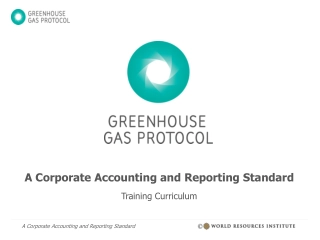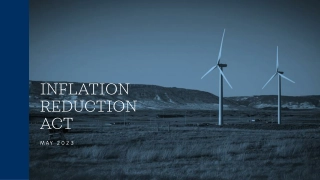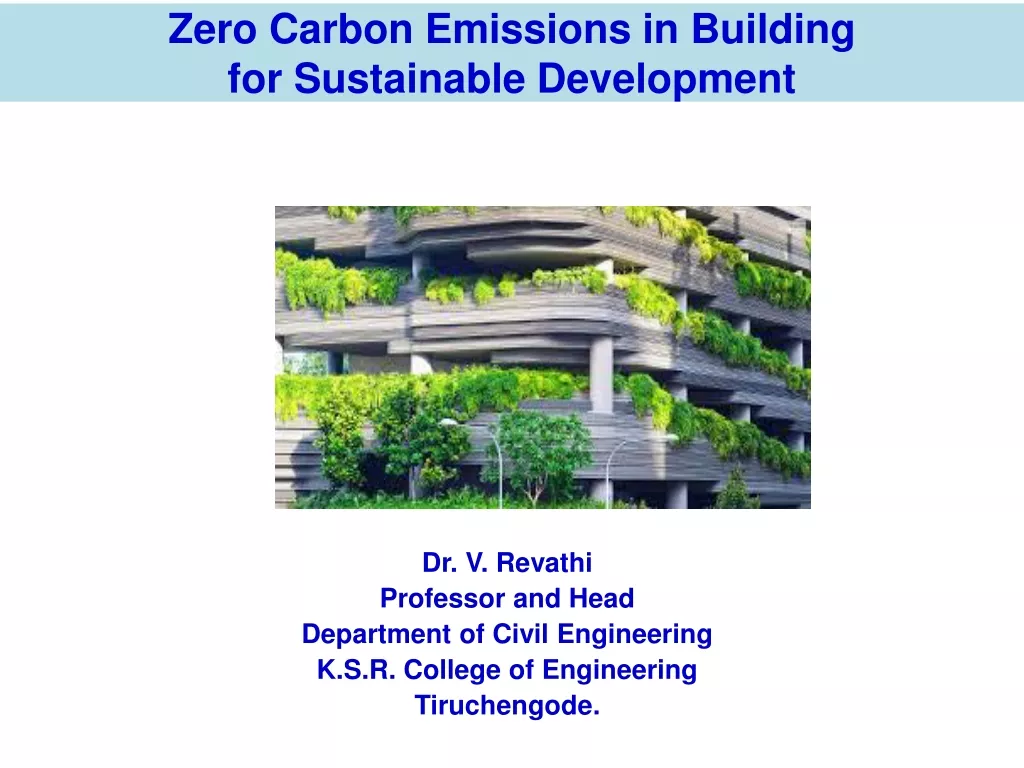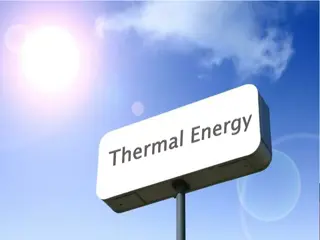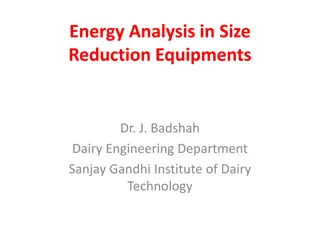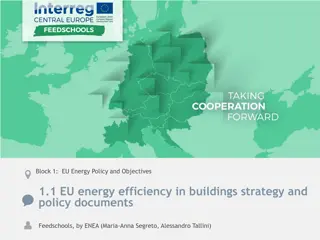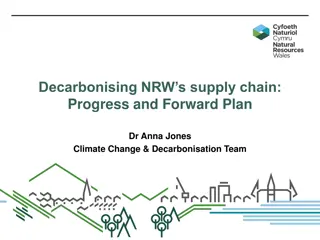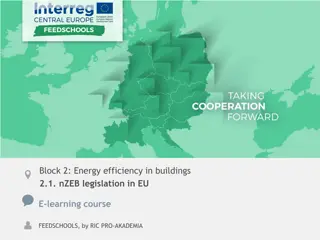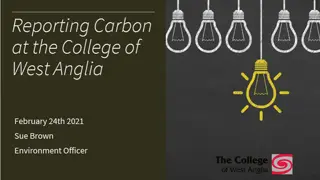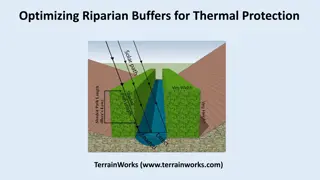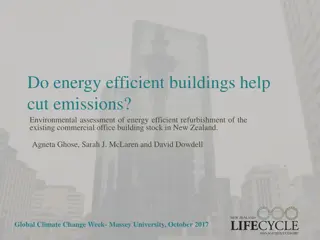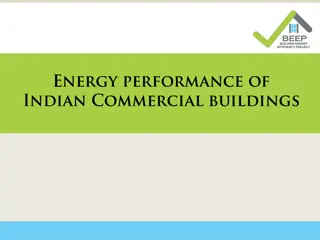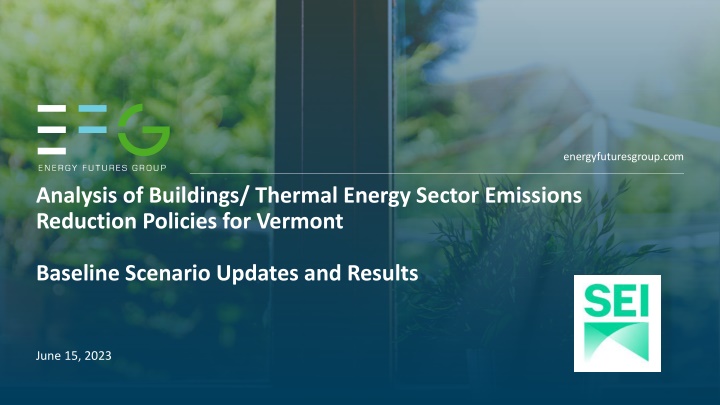
Analysis of Buildings/Thermal Energy Sector Emissions Reduction Policies
This report presents updates and results of emission reduction policies for Vermont's buildings and thermal energy sector. It focuses on the impacts of new policies, economic drivers, and changes in energy consumption. The analysis includes scenarios for residential sector changes and projections for future energy needs.
Download Presentation

Please find below an Image/Link to download the presentation.
The content on the website is provided AS IS for your information and personal use only. It may not be sold, licensed, or shared on other websites without obtaining consent from the author. If you encounter any issues during the download, it is possible that the publisher has removed the file from their server.
You are allowed to download the files provided on this website for personal or commercial use, subject to the condition that they are used lawfully. All files are the property of their respective owners.
The content on the website is provided AS IS for your information and personal use only. It may not be sold, licensed, or shared on other websites without obtaining consent from the author.
E N D
Presentation Transcript
energyfuturesgroup.com Analysis of Buildings/ Thermal Energy Sector Emissions Reduction Policies for Vermont Baseline Scenario Updates and Results June 15, 2023
Baseline Scenario Revised Updates and Results 2 6/15/23 Today s Discussion 1. Presentation to Thermal Task Group and X-Sector Sub-committee on Updates and Results to LEAP model 2. Summary of major updates to Baseline scenario in model version 3.08 3. Selected input assumptions (with additional detail shown by request in model) 4. Focus on Building and Transportation Sector Updates Reflecting Inflation Reduction Act, and Advanced Clean Cars and Trucks 5. Aggregate results (emissions, energy consumption)
Baseline Scenario Revised Updates and Results 3 6/15/23 Baseline Update Objectives 1. Latest adoption levels information from EEU s and other sources 2. Consider impacts of new policies and programs Federal Inflation Reduction Act Federal Infrastructure and Jobs Act Vermont Weatherization Act 185 Multi-State Advanced Clean Cars II adoption Multi-State Advanced Clean Trucks 3. Major changes in economic/demographic drivers 4. Fuel prices, calibration, and model streamlining
Baseline Scenario Revised Updates and Results 4 6/15/23 Residential Sector Change Log Residential Sector Change Log units Ensure that costs of wood stoves, pellet stoves and pellet boilers aligns with Tier III planning tool:Residential Wood Stoves - Measure cost $3,319; Measure life = 18 years Residential Pellet stoves - Measure cost $4,400; Measure life = 18 years Residential Pellet boilers or furnaces - Measure cost $20,000; life = 20 years Updated number of projected residential retrofits to include forecasts provided by EVT and OEO through 2030 and 2033, respectively, after which the annual number of retrofits is held constant. In addition, IRA-attributable retrofits from 2050-2030 are included. Update projected heat pump shares based on impacts of EVT rebate program and IRA. Heat pumps expected to meet 44% of existing household heating needs (16% in urban multi-family households) by 2050. In newly constructed homes, heat pumps to meet 85% of heating needs by 2050. Update projected heat pump shares based on impacts of EVT rebate program and IRA. Heat pumps expected to meet 44% of existing household heating needs (16% in urban multi-family households) by 2050. In newly constructed homes, heat pumps to meet 85% of heating needs by 2050. Adjusted share of heating load met by single and double-headed heat pumps. Single headed heat pumps meet 30% of household heating needs, while double-head meet 55% (formerly 40% and 66%, respectively). Reduce cost of single-headed residential mini-split heat pumps to 2/3 that of double-headed Increased share of household heating needs met by advanced pellet boilers to meet all of a home's heating requirements Add air-to-water heat pumps (a new technology not in previous model) into baseline Adjust wood and pellet stove penetrations to gradually increase to 0.25% of rural single family housing stock per year. Add advanced pellet boilers into baseline (previously reserved only for mitigation scenario), distributing 100 units/year among single- and multi-family homes. In rural single-family homes only, additional wood and pellet stoves are added, eventually converting 0.25%/year (by 2030) to wood and pellet stoves. In addition, displacement rules for heat pumps were refactored so that heat pumps do not affect wood and pellet stoves in rural single-family homes. Incorporated historical retrofits completed in 2020 and 2021 from all weatherization programs. Updated historical space heating technology shares spanning all household types. Major changes included generally reducing heating provided by oil and propane furnaces in favor of oil and propane boilers, increasing the share of natural gas-heated homes, and updating shares of household heat supplied by heat pumps. Increased share of household heating needs met by central ducted heat pumps to meet all of a home's heating requirements Update household number projection to align with change in total residential customer account forecasts through 2040, provided by Cadmus, mirroring those used for 2022 Energy Efficiency Potential Study. Values were converted to an multiplicative index relative to 2019, and then applied to previously-estimated 2019 statewide commercial floorspace. After 2040, the index grows at the average annual growth rate calculated from index values 2030-2040. Overall, households grow from 340 thousand in 2020 to 348 thousand in 2050. Introduce heat pump water heaters in baseline, reaching 47% of water heating needs in single- family households by 2050. Updated historical water heating technology shares Calibrate residential energy use, including energy consumption through 2019 from SEDS.
Baseline Scenario Revised Updates and Results 5 6/15/23 Transportation Sector Change Log Include $1,500 200A service panel upgrade costs for 70% of newly sold passenger car or light truck EVs. Added Advanced Clean Cars II rule sales targets for passenger cars, previously only obeyed in mitigation scenario. Sales of model category "Passenger Cars" reach 100% EVs by 2035. Added Advanced Clean Trucks rule for sales of vehicle classes 2b-3, 4-8 and 7-8, with intermediate sales targets inscribed in VT DEC's Advanced Clean Trucks Fact Sheet. Imperfect overlap of model categories with ACT rule categories means that sales of the entire model category "Light Trucks" reaches 90% ZEV by 2035, "Medium Duty" sales reach 75% ZEVs by 2035, and "Heavy Duty" sales reach 40% ZEVs by 2035. Vermont DEC. Removed medium-duty PHEVs and FCVs from forecast Calibrate transport energy use, including energy consumption through 2021 from SEDS. Updated fleet-wide vehicle-miles travelled estimates using Office of Highway Policy Information VM-2 data for 2020 and 2021, recalibrating model's total VMT forecast. Update current numbers of EVs and PHEVs on road at beginning of 2023
Baseline Scenario Revised Updates and Results 6 6/15/23 Cross Cutting, Commercial, and Industrial Change Log Residential Sector Change Log Cross Cutting: Update fuel costs using AEO 2023 Updated the baseline scenario to include a biofuel blending target for heating oil in line with New York Senate Bill S3321A relating to bioheating fuel requirements (https://www.nysenate.gov/legislation/bills/2021/s3321). Heating oil consumed in the residential and commercial sectors now reaches 5% in 2022, 10% in 2025, and 20% in 2030 (all percentages measured by volume). Commercial: Industrial: Calibrate industrial energy use, including energy consumption through 2021 from SEDS. Update commercial floorspace projection to align with change in total commercial customer account forecasts through 2040, provided by Cadmus, mirroring those used for 2022 Energy Efficiency Potential Study. Values were converted to an multiplicative index relative to 2019, and then applied to previously-estimated 2019 statewide commercial floorspace. After 2040, the index grows at the average annual growth rate calculated from index values 2030-2040. Overall, floorspace grows from 139 million sqft in 2020 to 227 million sqft in 2050. Change ASHP efficiency (reduce ASHP COP for the most efficient devices from 3.3 to 2.6) Update number of projected heat pumps Update recent 2021 technology shares for space heating and lighting end-uses, based on 2021 Vermont Business Sector Market Characterization and Assessment Study Calibrate commercial energy use, including energy consumption through 2021 from SEDS.
Baseline Scenario Revised Updates and Results 7 6/15/23 Revised Baseline Emissions Thermal Sector 25% Sector Reduction from 2005, 2,280 MTCO2e 40% Sector Allocated Reduction from 2018, 1,758 MTCO2e 80% Sector Allocated Reduction from 2018, 586 MTCO2e
Baseline Scenario Revised Updates and Results 8 6/15/23 Revised Baseline Update Input: Heat Pump Forecast Incorporated EEU forecast of heat pumps pre-IRA Based on EVT and BED Demand Resource Plans and recent market data Included heat pump projections as a result of IRA funding on top of this forecast (manufacturer estimate of 6% increase in estimated annual market activity) Single-head/double-head/central air-source heat pumps provide 25%/45%/100% of household heating needs, respectively
Baseline Scenario Revised Updates and Results 9 6/15/23 Revised Baseline Update Input: Heat Pump Forecast Residential Heat Pump Load 100 90 80 70 % of heat 60 50 40 30 20 10 2020 2025 2030 2035 2040 2045 2050 Heat Pump Heating Load Existing Heat Pump Heating Load Urban Multi-Family Heat Pump Heating Load New Build
Baseline Scenario Revised Updates and Results 10 6/15/23 Revised Baseline Update Input: Heat Pump Forecast Residential Heat Pump Deployments 500 Thousand Units 400 300 200 100 2020 2025 2030 2035 2040 2045 2050 Single Family ASHP 2-Head Multi-Family ASHP 2-Head Single Family ASHP Central Multi-Family ASHP Central Single Family ASHP 1-Head Multi-Family ASHP 1-Head Single Family GSHP 1-Head Multi-Family GSHP 1-Head Single Family ASHP 2-Head with Wx Multi-Family ASHP 2-Head with Wx Single Family ASHP Central with Wx Multi-Family ASHP Central with Wx Single Family ASHP 1-Head with Wx Multi-Family ASHP 1-Head with Wx Single Family GSHP 1-Head with Wx Multi-Family GSHP 1-Head with Wx
Baseline Scenario Revised Updates and Results 11 6/15/23 Revised Baseline Update Input: Wood and Pellet Stoves Small number of advanced pellet boilers introduced among single- and multi-family homes By 2030, 0.25% of rural single-family homes each year converted to wood or pellet stoves; heat pumps do not displace them
Baseline Scenario Revised Updates and Results 12 6/15/23 Revised Baseline Update Input: Wood and Pellet Stoves Rural Single-Family Detached Home Heating Technologies, BAU 100% 90% 80% % useful heat 70% 60% 50% 40% 30% 20% 10% 0% 2015 2020 2025 2030 2035 2040 2045 2050 ASHP Central GSHP Natural Gas Boiler Oil Boiler Propane Furnace ASHP 1 Head Electric Furnace Natural Gas Furnace Oil Furnace Pellet Stove ASHP 2 Head Electric Resistance Heater Natural Gas Heat Pump Propane Boiler Advanced Pellet Boiler
Baseline Scenario Revised Updates and Results 13 6/15/23 Revised Baseline Update Input: Weatherization Forecast Baseline annual retrofit forecasts from OEO (2023-2033), VEIC (2023- 2030), and existing (from 2021) forecasts from VGS and BED Revision: Additional retrofits added as a result of IRA and Clean Heat Homes funding $30 million from HOMES program of the IRA and $8.5 million from Clean Heat Homes Translated this into number of retrofits based on average cost of retrofit Adds 3,286 single-family, 1,486 multi-family retrofits 2025-2030 Following forecasts, annual retrofits held constant through 2050
Baseline Scenario Revised Updates and Results 14 6/15/23 Revised Baseline Update Input: Weatherization Forecast
Baseline Scenario Revised Updates and Results 15 6/15/23 Revised Baseline Update Input: Residential Heating Fuels Energy Demand for Space Heating in Residential Buildings by Fuel 25 20 Trillion BTU 15 10 5 2020 2030 2040 2050 Heating Oil Electricity Distributed Natural Gas Propane Wood Wood Pellets
Baseline Scenario Revised Updates and Results 16 6/15/23 Revised Baseline Update Input: Residential Water Heating By 2050, nearly 50% of single-family water heating is provided through heat pumps Outside of single-family households, technology mix remains constant Fossil water heating efficiency increases
Baseline Scenario Revised Updates and Results 17 6/15/23 Revised Baseline Update Input: Commercial Floor Space After indexing to forecasted number of customer accounts through 2040 (used in 2022 Energy Efficiency Study), commercial floor space reverted to floor space projection in the original CAP analysis. Commercial Floorspace by Building Category and Construction Year 250 Post 2007 of Fully Retrofit 200 Million Square Feet Pre 2007 with Insulation Retrofit 150 Pre 2007 with HVAC Retrofit 100 Pre 2007 50 "Updated" floorspace projection 2.21-3.07 2015 2020 2025 2030 2035 2040 2045 2050
Baseline Scenario Revised Updates and Results 18 6/15/23 Revised Baseline Update Input: Commercial Heat Pump Forecast Commercial heat pump forecast tied to residential forecast, preserving same (90%R/10%C) relationship as earlier CAP work
Baseline Scenario Revised Updates and Results 19 6/15/23 Revised Baseline Update Input: Commercial Heating Fuels
Baseline Scenario Revised Updates and Results 20 6/15/23 Revised Baseline Update Input: Road Transport ACCII for Passenger Cars (100% sales BEVs and PHEVs by 2035) ACCII/ACT for Light Trucks (90% sales BEVs and PHEVs by 2035) ACT for Medium-Duty Vehicles (75% sales BEVs by 2035) ACT for Heavy-Duty Vehicles (40% sales BEVs by 2035) Additional modifications discussed, but not included to date: Limit PHEVs to be no more than 20% of all light-duty EV sales, using newly-created 70-mile range PHEV Migrate all heavy-duty PHEVs to a newly created BEV technology Limit heavy-duty fuel cell vehicle sales to 10% of total
Baseline Scenario Revised Updates and Results 21 6/15/23 Revised Baseline Update Input: Road Transport Passenger Car Sales Shares by Technology 100% 90% 80% 70% % of sales 60% 50% 40% 30% 20% 10% 0% CNG Diesel Diesel Hybrid E85 Flex Fuel EV A EV B EV C Gasoline Gasoline Hybrid Gasoline PHEV A Gasoline PHEV B Fuel Cell
Baseline Scenario Revised Updates and Results 22 6/15/23 Revised Baseline Update Input: Road Transport Light Truck Sales Shares by Technology 100% 90% 80% 70% % of sales 60% 50% 40% 30% 20% 10% 0% CNG Diesel Diesel Hybrid E85 Flex Fuel EV A EV B EV C Gasoline Gasoline Hybrid Gasoline PHEV A Gasoline PHEV B Fuel Cell
Baseline Scenario Revised Updates and Results 23 6/15/23 Revised Baseline Update Input: Road Transport LDVs by Technology, BAU 700 600 Thousand Vehicles 500 400 300 200 100 0 2020 2030 2040 2050 CNG Diesel Diesel Hybrid E85 Flex Fuel EV A EV B EV C Gasoline Gasoline Hybrid Gasoline PHEV A Gasoline PHEV B Fuel Cell
Baseline Scenario Revised Updates and Results 24 6/15/23 Revised Baseline Update Input: Road Transport MDV/HDVs by Technology, BAU 80 70 60 Thousand Vehicles 50 40 30 20 10 2020 2030 2040 2050 EV or PHEV Gasoline Diesel Alternative Fuels
Baseline Scenario Revised Updates and Results 25 6/15/23 Revised Baseline Update Results
Baseline Scenario Revised Updates and Results 26 6/15/23 Revised Baseline Update GHG Results
Baseline Scenario Revised Updates and Results 27 6/15/23 Revised Baseline Update Results Adjusted Net Load in BAU Scenario 2,500 2,000 Megawatts 1,500 1,000 500 2020 2025 2030 2035 2040 2045 2050 Load, net of BTM PV and 75% of EV load BTM PV at peak 75% of EV charging at peak
6/15/23 Questions and Discussion

